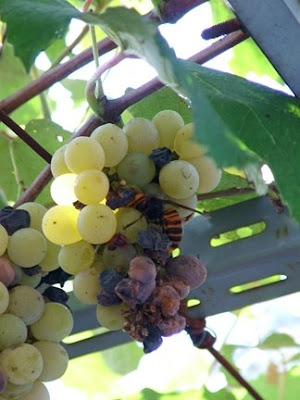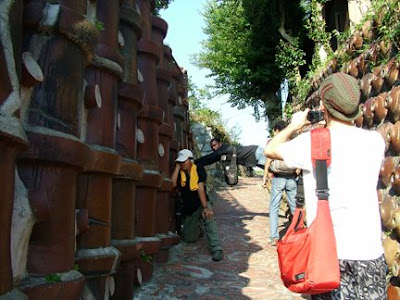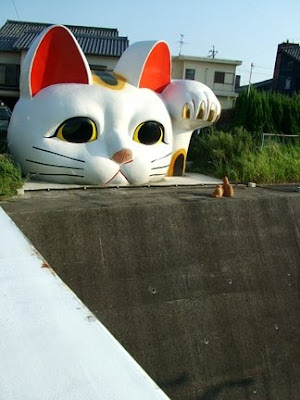I probably took a couple hundred pictures, but I won't post all of them :)

It was a very foggy 6a.m. when we left Shigaraki.

Waiting for one of the many trains we took to get to Tokoname.

Walking into the INAX Tile Museum - very interesting... if you like tiles.



Some of the beautiful work on display at the INAX gallery.



Also on the INAX grounds there was a museum built around an old kiln. It was a neat idea, you could see the kiln, and you could see the artwork around it. And upstairs, they had displays of different kinds of ceramic toilets... how... fascinating?

"Watch your head!" (This may have been the first time in my life I've actually had to pay attention to a sign like this.)

The museum also showed a traditional rokuro (throwing wheel) setup. I would love to try one of these someday!


More really great work, on display in a small gallery at the "Tile Workshop" at INAX, where you could also peek in and see how they manufacture tiles.



"So, where are we going now?"
On the Pottery Path of course. So much to see!

A beautiful wall of glazed bricks.

Occasionally, when we were high enough, we could see the sea! Or ocean, rather.

From one vantage point, you could see at least 6 of the old kiln chimneys, if not more. I think if you look closely, 5 of them are visible in this picture.

There were little shops everywhere, and all kinds of neat pottery. I was particularly fond of this fountain (the teapot is maybe 2 or 3 feet in diameter!).

And I thought this was a particularly awesome fish tank.

A few shops were set up inside old kilns. Did I mention these are huge kilns?

You can see the years and years of buildup on the bricks inside. How better to show off pottery than where it was created!

Very very big kiln, little itty bitty kiln (well, as tall as me at least, if you want to call that a small kiln).

Another of the old kilns... They all seemed such a natural part of the environment.

Most of the sidewalks were a fun combination of pottery and concrete - very pleasant.

Another fun way of keeping goldfish. These large "fish bowls" were all over outside, lillypads and all.

I have a very strong urge to paint a little scene like this. So peaceful.



Actually, not only did most of the sidewalks have pottery embedded in them, most of the embankments were supported with some kind of ceramics. The guide map refers to some of the pots as "anti sulfuric acid bottles" and others are Shochu (a type of liquor) bottles. Bases from firing pipes and the pipes themselves are also commonly used.

Yes, those are normal-sized grapes. Little smaller than a bottle cap, maybe the size of the first joint of my thumb.
So no, that is certainly not a normal-sized bee. Why must this country have outrageously sized insects???

A closer look at a couple of the old chimneys.

This kiln is about the size of a very small house. Most of them are.
Actually, we thought this one might still be in use since it hasn't quite succumbed to its surroundings yet.

Tokoname boasts the largest Noborigama (climbing kiln) in Japan. As the guide map says, "It is only here in Japan that chimneys of 10 form a line."

I couldn't get far enough away to really show the scale of the whole thing, but maybe you get the idea.

Tile mosaics like this, made by local children, were pretty common. And quite cute.

Fun pottery-lined passageway. And perhaps proof that boys will be boys, no matter the place or the culture. Then again, I would've joined them, so maybe it's just human nature :)

Obligatory photo of myself, since there were a couple comments about such things :)

These little buddhist statues are pretty common throughout Japan. You just don't always see them with ceramic plates for hats.

Just to give you an idea of the scale...

...of the cat...

...on top of the very high wall, with cat sculptures displayed along the walkway at the bottom.

A little studio, a potter trimming his pot.

Wouldn't you like to have this lovely ceramic bathtub? For about 600000Y? $6000? Oh, maybe not.

The wall of cats, from a lower perspective. And the pretty tile mosaic at the end of it.

We finally headed back, after a long day of walking and pottery. And took a Shinkansen (Bullet Train) back so as not to miss the last bus to Shigaraki. In case you haven't seen the impressive 12 or so story Kyoto station, see above.

Before heading home, we stopped for dinner at one of Kyoto Station's many restaurants. Japan does amazing things with omlettes. In this case, a pile of rice, a large pancake-like egg, curry sauce, and ketchup... Sounds odd, tastes amazing.
So, thus ends a long and fantastic day!
P.S. Thank you all so much for the lovely birthday wishes. It was great day (see above!). And the kind people here had a little party for me last night. So nice to be in good company while away from home!




















